This week’s Monday Roundup is brought to you by Wheelhouse Lofts. Just steps away from the Springwater Corridor, you can live in a place that welcomes you and your bike with open arms.
Here are the most notable items we came across in the past week…
LPIs FTW: Seattle’s DOT has announced that leading pedestrian intervals (LPIs), which give crosswalk users get a head-start into an intersection, are now the preferred treatment whenever a signal is upgraded, maintained, or installed.
E-bike rebates: The province of British Columbia in Canada has a policy that Oregon should have passed this session: People can get an $850 rebate toward the purchase of a new electric bicycle when they scrap their toxic, gas-powered cars.
Ped-E-cabs: People who operate pedicabs hope the recently passed e-bike legislation in New York City gives them a chance to lift the existing ban on motors on their large, people-carrying vehicles.
Our road safety crisis: Streetsblog crunched the 2018 traffic fatality numbers and they paint a devastating picture of inequity: Biking and walking deaths are up; but fewer people inside cars were killed.
I-5 project is a boondoggle: OSPIRG, an environmental group, released their annual report on highway boondoggles and of course the I-5 Rose Quarter freeway expansion project made it on the list.
Advertisement
Major Taylor gets his due: NPR’s venerable Fresh Air interview show featured author Michael Kranish who has written a new book on the race barrier-breaking-sports-superstar-cyclist Major Taylor.
Grand Tour on an e-bike: As electrified bicycles creep ever closer into mainstream acceptance, organizers offered an e-bike race on the same course as the legendary Giro d’Italia.
E-bike study: Recent research on people who switched to e-bikes from driving/transit or standard bikes revealed (among other things) that because they take longer trips on average, e-bikes users get the same net physical benefits as non-e-bike riders.
Manhattanites on bikes: An observational study of people riding bikes in Manhattan found that cell phone use while cycling has shot up in recent years.
City-killers: The reliable George Monbiot had me with his lede: “What is the best way of wrecking a city? Pour cars into it.”
Take a (looong) walk: The mind-boggling Sri Chinmoy Self-Transcendence Race requires participants to walk around one block in Queens, New York 5,649 times. It’s like the Ladds 500 on steroids, times a thousand.
Dream a little dream: Check out these inspiring and lovely photos of the best bike infrastructure in the world that are part of the Bicycle Architecture Biennale competition being held in Amsterdam
— Jonathan Maus: (503) 706-8804, @jonathan_maus on Twitter and jonathan@bikeportland.org
Never miss a story. Sign-up for the daily BP Headlines email.
BikePortland needs your support.


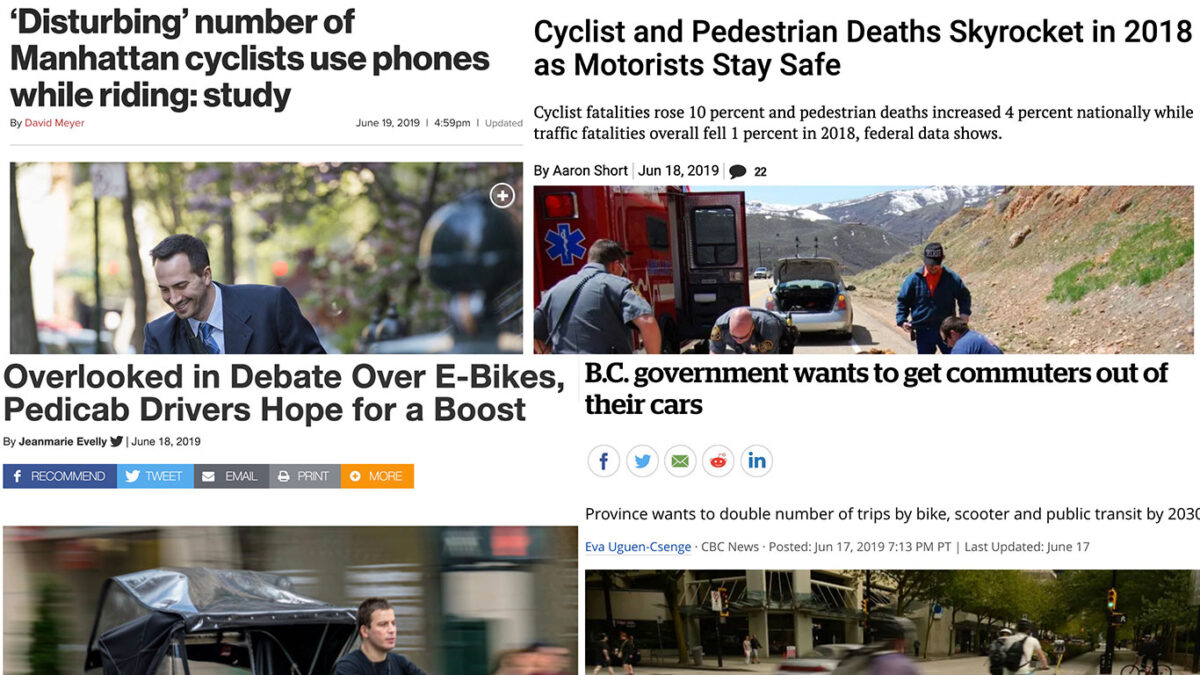
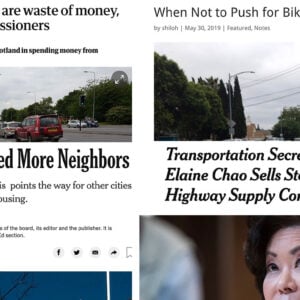
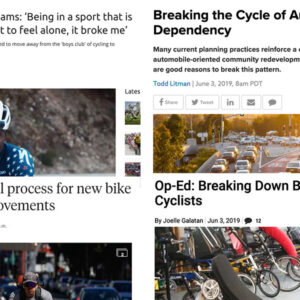
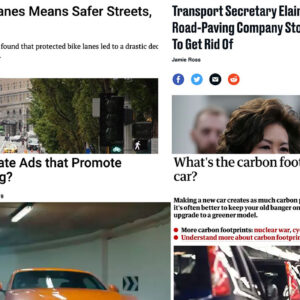
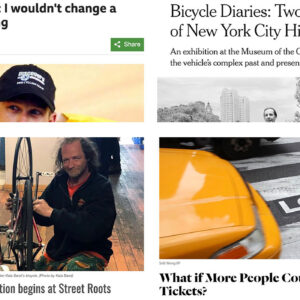
Thanks for reading.
BikePortland has served this community with independent community journalism since 2005. We rely on subscriptions from readers like you to survive. Your financial support is vital in keeping this valuable resource alive and well.
Please subscribe today to strengthen and expand our work.
I really regret not trying to ride the Mortirolo when I was in Bormio. The weather was bad and I was shot from having ridden the Stelvio and Gavia in the days before.
Some day! And hopefully not on a e-bike, either.
Fantastic news about e-bikes. Recently purchased a couple for myself and husband, and have been enjoying ditching the car and commuting to work more often (and not arriving covered in sweat!). Would love to get some money back on that.
While I have definitely left my truck parked twice as often, my eBikes won’t 100% replace my Tacoma or bicycle. I still got stuff to haul, 6 bags of groceries or more to toodle home, and passengers to get from SE to places like Molalla and Astoria.
But it’s undeniable that I’ve gone from driving my auto at least 5 days a week, and pedaling about 10-12 total miles on weekends, to pedaling with power 3-4 days a week, averaging 18-20 miles per day whenever mission and weather allow for it, and just throwing a bag or two of groceries in the luggage more often
You’re a great example of why ebikes are nothing but a good thing. Also, they will for sure be a kind of gateway drug that brings some people into pedal-only bikes. One thing that will help is that some non-bicycle major companies are getting into the market–Yamaha, for instance–and I’d bet that for every American that’s heard the names Cannondale or Specialized, ten thousand know the name Yamaha. This has to help increase non-cyclists comfort with the idea, that they don’t have to go into a bike store to buy one. Bike store self-lacerators should NOT beat themselves up about “why aren’t they coming to us,” but realize that the bike dealer channel is not even on the radar of a whole lot of potential ebike buyers but motorcycle dealers are.
Why limit the rebate program to ebikes? All bikes should be eligible, FFS.
Thank you for pointing that out.
It is such a shame that in capitalism the urge to continually bias the Middle Class consumer’s attention toward the (ever) more expensive goody, is ever present, and that our incentives predictably reify this bias.
Hey, North Americans need some sizzle with their steak–to some, an ebike may impress them as “kind of a motorcycle” and get them out of that car part of the time. I really believe that getting people to drive less is so imp0rtant that any means are justified!
“North Americans need some sizzle with their steak”
Need?
The Middle Classes certainly feel entitled, but I’m not sure about need. And besides where has this exceptionalism got us? Our continual demand for these features, where does it end?
“Why limit the rebate program to ebikes?”
Cuz, duh—nobody uses a “regular” bike to replace car trips. Not even if they qualify for the rebate by actually getting rid of a car.
I know plenty of people, my best friend and myself included. who most definitely replace car trips with my non-power assisted bicycle. For example, I regularly commute by bike in the suburbs of New Jersey, and my friend commutes by bike in a mid-sized town in Minnesota.
E-bikes already have mainstream acceptance.
It seems to me like the only haters are other (traditional) cyclists.
Mainstream acceptance vs haters.
I think a more nuanced spectrum of opinion would be more useful.
Consumer approval logged at the cash register is but one way we, collectively, voice our preferences.
I have nothing against e-bikes. Wish I had one myself. But I am concerned for the safety of some e-bike riders whose travel speeds are outpacing their abilities. Of course, I have the same concern for many drivers too.
Mmmk, I don’t mean to sharpshoot, but I feel this sentiment needs to be addressed, as it comes from the realm of misconception and a little bit of competitive-grade rider ego. Not exactly a rare phenomonon in this bike-centric town.
My eBike riding speed is no faster than my routine road bike speed. It’s governed at 20mph. If it exceeds that under power or the 1000w limit, it’s not an e-bicycle anymore, it’s a motorized vehicle with all the DMV requirements of a motorcycle, which isn’t on the bikeways with you.
At 16-20 mph, I still get passed regularly by the Tour-De-Portland enthusiast riders. An awful lot of folks have had no clue that there were eBikes on the Springwater with them all along the last few years, and would be hard pressed to spot most models without really stopping to inspect the bike, hence, they haven’t had many vocal opinions based on real world experience. Just theorycraft and internet megaphones.
Please don’t go setting yourself up as the judge, jury, and executioner of who has what abilities and how they need to be controlled per your views. I respect the nod towards safety, but it’s too late for a panic about rider skills now.
“My eBike riding speed is no faster than my routine road bike speed.”
Okay, so you probably have riding skills developed over time. I would say, on average, most people who can pedal at a 20mph pace have learned how to handle themselves at those speeds. I’ve seen very few ebikes about, but on those ebikes I have seen a higher than average rate of riders zipping through dooring zones and right hook zones without slowing down at all, which gives me pause.
“Please don’t go setting yourself up as the judge, jury, and executioner of who has what abilities and how they need to be controlled per your views.”
I don’t know where you got that from my one sentence. I merely observed that some of these cyclists appeared to have very little awareness of their surroundings, as compared to their rate of travel. Even drivers who are highly aware of the presence of cyclists are more likely to be caught off-guard at the appearance of an ebike rider zipping uphill on their right at 20mph as they are preparing to turn.
E-bikes remind me of the rise of Disco in the 1970’s. It was super popular, it brought participation and fame to demographics that had been left out of the mainstream music scene, it grew quickly and made many people a lot of money. But somehow you just knew it was going to end badly.
You read it here first, folks.
Huh?
After looking at the sketches and photos of current and proposed bike infrastructure in various places in europe it makes me face up to something I have suspecting for a long time now. Despite the declarations from government and cheerleaders in the media we are no longer a first world country. We have squandered our wealth on rackets in education, healthcare, transportation, banking , housing and the military and no longer have the will or the means to achieve world class standards in anything that matters outside of sports and entertainment.
Have you visited many places outside the USA? Residents here are part of the global 1%. There are millions of people literally risking death hiking through the desert to live here. Homeless people here have more belongings than most of the people that live in Africa. Just because the USA prioritizes less government involvement in public life than Europe does not mean the USA is not a 1st world country. I would love to see more spending on bike infrastructure and a lot less on military but we are extremely wealthy society by any measure.
Sorry, Jon, but bikeninja is correct: we really are a 3rd-world county now, based on almost any statistical projection you want to pick (infant mortality, gun deaths, obesity, transportation deaths, cost of medical care, and on, and on).
What he said.
I have to ask again if you visited Africa or Central America? The poverty you see there is unbelievable if all you have ever lived in or visited the US, Europe, Japan, or Australia. To think the USA is not a first world country is a lot like a multimillionaire living along Lake Oswego saying they are middle class. It really devalues the true suffering you see in real poor places. It is only by luck of birth and the hard work of our ancestors that enable us to live in amazing luxury here in the USA. Book a trip to Belize and take a walk outside the luxury compound where you are staying and you will see what a 2nd or 3rd world country is like. I’m willing to bet the price of the average bike ridden by someone reading this blog would be 2 years of average person’s income in Tanzania. Hyperbole is a great device but entirely disingenuous.
You are I think collapsing wealth, which you talk about in your reply, and First World/Third World distinctions. Third World countries, so called, have always featured wealthy enclaves, so what you are describing doesn’t distinguish us, make us any less Third World. And poverty, we have that too. In spades.
As for what characteristics would make someone feel that we in the US have dropped a few rungs, I don’t think you have to look beyond Fred’s list. Since you disagree, why not start with that?
I read the study about “cyclists using phones.” Unsurprisingly, the New York Post headline and photograph are misleading. The study didn’t address whether people were “using phones” in the manner depicted. It did count how many people were riding while wearing headphones or earbuds.
The study also looked at lots of other behaviors like wrong-way riding, behavior at red lights, bike lane use, and helmet use. It broke behaviors down by cyclist type (general rider vs commercial rider vs CitiBike rider) and gender.
It’d be interesting to compare these results to those of Portland. I’d hypothesize that the generally better bike infrastructure in Portland leads to better compliance in wrong-way riding, red light behavior, and bike lane use. Anyone got data to compare to?
My e-bike has saved me over $1500 in gas in the last 2 years, plus I was able to negotiate a modest discount on my auto insurance (State Farm) since my car mostly sits in the driveway… My daily e-bike commute still requires vigorous exercise, I’m just going faster now. 11 miles in 35 minutes, about 10 minutes more than if I was driving. When there’s heavy traffic I’m home faster than if I actually drove my car…
The bike infrastructure examples are inspiring.
What caught my eye were the dynamic, curving shapes, which fit with how bikes move. In comparison, sadly, we’re still building bike facilities that don’t even acknowledge that bikes don’t make 90-degree turns.
I’m thinking in particular of the Sellwood Bridge’s long, westside switchback ramp that consists of two bleak, long straightaways connected by a 180-degree turn, but there are plenty of other examples. Hardly anything to be excited about.
In comparison to some of these examples that celebrate movement, Portland is still building bike infrastructure projects that require people to get off their bikes and walk.
The article on the rise of ped/cyclist deaths, while car deaths have decreased, has a comment that should inspire a whole series of investigations! It deserves to be quoted in full:
Mark R. Brown says:
June 19, 2019 at 11:53 am
Some observation as a frequent cyclist/pedestrian and as a professional planner:
-Cars are bigger and more powerful than ever which encourages speeding and makes drivers feel more disconnected from the street.
-Bumpers are higher, placing them directly at ped/cyclist torso level.
-Drivers are more distracted than ever. It’s not even the texting – it’s the constant looking at nav maps for even the shortest trips.
-Navigation apps, including the ones Uber/Lyft drivers use, are bringing higher-speed through traffic onto local residential streets where peds/cyclists don’t expect it.
-Younger people (and older ones) want to walk and cycle more and are doing so even on streets that aren’t designed for it.
-The traffic engineering profession still prioritizes traffic speed over multi-modal safety at many levels of government.